|
 Back to index Back to index
|
| Itineraries > Maigmó Greenway |
|
|
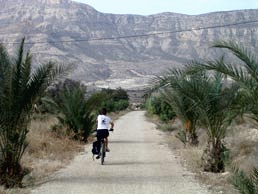
|
Tunnels and viaducts in a land of potters, vineyards, and badlands.
To build a railway from Alcoi to Alicante seemed a harebrained scheme: the broken, almost forsaken, terrain turned any attempt to build such a railway into a quixotic venture. Nevertheless, in the 1920s engineers took up the challenge and set about building a railway. Spectacular viaducts were thrown over rivers and ravines, and long tunnels were bored through the mountains. Although the railway never actually entered into service, today we can put these feats of engineering to good use as we travel along this adventurous and enjoyable Greenway.
|
| WRITE YOUR REVIEW
|
| Technical Data
|
|
 CONDITIONED GREENWAY CONDITIONED GREENWAY
|
Partially aconditioned greenway
LOCATION
Between the Apeadero de Agost and the Maigmó Pass
ALICANTE
Length: 22 km
Type of surface:
Compacted earth (loose gravel on some sections). Cement surface in tunnels
Natural setting:
|
|
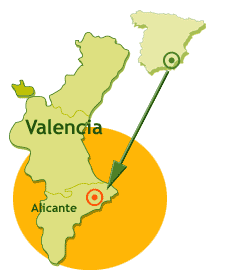 |
Mediterranean forest, badlands, gypsum ravines, and dry gullies
Cultural heritage:
Pottery museum (Agost)
Infraestructure:
Greenway. 7 tunnels (unlit), 2 viaducts, and 2 footbridges
How to get there:
Public transport: Agost: Renfe, Alicante-Albacete line, request stop
(*) Check the bicycle admission conditions on trains
Connections:
Alicante, 25 Km from Agost
|
|
|
|
| Description
|
|
Km. 0 / Km. 4,8 / Km. 10 / Km. 14,7 / Km. 22
|
This Greenway offers an upward climb to the Maigmó pass along a changing route that takes us through the low croplands of Agost and the Mediterranean forests of the Maigmó mountains, with their cover of Aleppo pines and carved by impressive ravines and dry gullies. The route climbs a total of 440 metres, from the 220m above sea level at Agost to the 660m of the Maigmó Pass. Before embarking on the trail, make sure your saddlebag or backpack is equipped with water, sun screen and a hat to protect yourself from the sun, and some kind of flashlight. Sadly the lighting equipment in the tunnels (installed when the railway was reclaimed as a Greenway) have been vandalized, so walkers and cyclists should carry flashlights or cycle lamps just in case. The Greenway is well signposted and equipped with safety rails, and there are a number of rest areas and interpretation boards along the way (at least there should be, though sadly some of these have also fallen prey to vandalism). It should also be noted that there are short stretches that we share with motor traffic. And, while we are unlikely to come across many vehicles since most of these stretches are merely access roads to neighbouring properties, it would be as well to take a little care. Being mindful of the above, let us set off.
Km 0
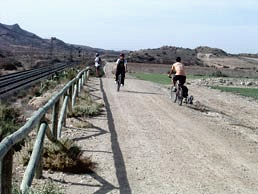 The route begins at the Apeadero de Agost. A little road takes us to this station which is 4 km from the village. Nowadays, no trains on the La Encina-Alicante line stop here unless requested in advance, but if we have arrived at the station by car, here is a good place to park before setting off down the Greenway. The route begins at the Apeadero de Agost. A little road takes us to this station which is 4 km from the village. Nowadays, no trains on the La Encina-Alicante line stop here unless requested in advance, but if we have arrived at the station by car, here is a good place to park before setting off down the Greenway.
However, for those choosing to follow the trail downhill, from the Maigmó Pass to Agost, the way to get to the head of the trail is to turn off the Alicante-Alcoi (A7) motorway just past the Maigmó Pass service area and take the underpass under the motorway: From there a roundabout leads us to a service road back in the direction we came from. A few metres further on we will see a dirt road leading to a rest area where the trails starts.
Returning to the Apeadero de Agost, the Greenway starts off down a compacted earth track running parallel to the active railway line. A few metres further on an intersecting lane with no bridge for Greenway users means we need to make a detour down a short but steep slope and up the other side to the level of the railway again. This is complicated for wheelchair users and inexpert cyclists.
The Greenway takes us through an area of farmland where grapevines, olive trees, and other crops lend colour to a stretch of trail which has been planted with olive, pomegranate, and other small trees which in a few years will provide some shade on this hot and dusty Greenway. After a few level crossings with tarmacked farm roads (watch out for other traffic!) and a bridge at Km 4, the trail heads for the village of Agost, down a lane lined with palm trees. This village will be the first and last one we encounter on our route so it is a good place to stock up on supplies. Fans of traditional pottery may wish to visit the pottery museum and buy one of the typical Agost botijos (earthenware water jugs), which are as white as the land that they come from.
Km. 4,8
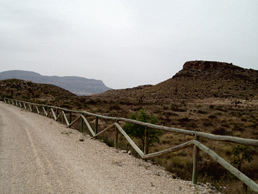 Back on the Greenway, a recently built footbridge (Km 4.8) takes us safely over the Novelda to Agost road (CV 820). More straight tracks between orchards and crop fields take us to another footbridge, this one longer and more elegant than the one before, located at Km 6.9. From here we get a good view down to the Rambla del Derramador, a dry gully, one of many we will be crossing before our journey ends. Back on the Greenway, a recently built footbridge (Km 4.8) takes us safely over the Novelda to Agost road (CV 820). More straight tracks between orchards and crop fields take us to another footbridge, this one longer and more elegant than the one before, located at Km 6.9. From here we get a good view down to the Rambla del Derramador, a dry gully, one of many we will be crossing before our journey ends.
After another level crossing with a tarmacked farm road the Greenway, once again lined with palm trees, enters one of the longest cuttings on the route (Km 9), which makes a sweeping curve to the left. The height of the loamy walls of the cutting and two graceful arches belonging to bridges carrying farm tracks over the railway are a blessing when the sun beats down. This area is known locally as Plá Aceituna.
Km. 10
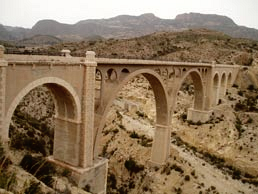 The next kilometre is marked by the Rambla del Tarraig gully (Km 10) which we skirt around on a high embankment that curves to the right which allows us to scan the horizon and the nearby Sierra del Maigmó mountains. At the end of theembankment comes a short cutting in which the surface is paved with cement to protect it against run-off water. Now we leave the greenness of the crop lands behind and enter into the whiteness of the arid gypsum landscape of the badlands. Km 11 takes us over two more bridges and a short viaduct. We continue to climb gently upwards as the landscape begins to turn green once more. The first thickets and Aleppo pines start to appear after the first tunnel on our route (Km 12.1). The tunnel is short and straight and so we can pass through it without having to take our flashlight from our backpack. On the far side is another surprise: the Forn del Vidre Viaduct (140m). Once over this viaduct a picturesque cutting (Km 13), protected against rock falls, leads us quickly to the next rest area and a large irrigation reservoir. With its pine trees providing shade, a cycle park, and picnic tables it is a good place to take a breather. The next kilometre is marked by the Rambla del Tarraig gully (Km 10) which we skirt around on a high embankment that curves to the right which allows us to scan the horizon and the nearby Sierra del Maigmó mountains. At the end of theembankment comes a short cutting in which the surface is paved with cement to protect it against run-off water. Now we leave the greenness of the crop lands behind and enter into the whiteness of the arid gypsum landscape of the badlands. Km 11 takes us over two more bridges and a short viaduct. We continue to climb gently upwards as the landscape begins to turn green once more. The first thickets and Aleppo pines start to appear after the first tunnel on our route (Km 12.1). The tunnel is short and straight and so we can pass through it without having to take our flashlight from our backpack. On the far side is another surprise: the Forn del Vidre Viaduct (140m). Once over this viaduct a picturesque cutting (Km 13), protected against rock falls, leads us quickly to the next rest area and a large irrigation reservoir. With its pine trees providing shade, a cycle park, and picnic tables it is a good place to take a breather.
After this short respite we move on towards the next major landmark on our route: the Palomaret Viaduct (Km 14). This is another impressive engineering work, over 200m long, on which we may encounter cars since this is one of the tarmacked sections of the route which we have to share with motor traffic (but only for 600m).
Km. 14,7
EWe move among dry gullies and Aleppo pines before reaching (at Km 14.7 and Km 15.7) tunnels number 22 and 23 of the 24 tunnels that the original Alicante to Alcoi railway used to boast.
We are now in a section dominated by cuttings, high embankments, dry gullies, and nearby claystone hills, and can see how the CV 827 road to our right winds its way up towards the Maigmó mountain in a series of spectacular, breathtaking curves. This is one of the most picturesque parts of the route; the air is redolent with the aroma of pine trees and the tunnels seem to add a special magical quality. The 381m long, totally dark tunnel at Km 17.4 is a prelude to the last tunnel on the route, which delves into the depths of a hill known as the Collado de la Horna. But before that tunnel, on the right hand side of the trail, there is another rest area set among a large stand of pine trees in case we need to make a stop.
The last tunnel on the route (Km 18.6) is by far the longest. The installation of cat’s eyes throughout the length of the tunnel was no doubt well intentioned but the result is clearly insufficient. So, flashlight at the ready and with a renewed spirit of adventure, we embark on the 525m of the tunnel. In defence of this and all the other tunnels on the route, the cement surface makes them safe and easy to pass through. This tunnel is unusual for two reasons: it is home to the kilometre marker for Km 19, and it passes through a mining area deep beneath the Maigmó Pass.
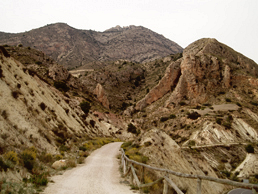 Km. 22 Km. 22
The final 3 kilometres is slightly more uphill but the landscape and the views are well worth the extra effort. In the final kilometre we can see the Alicante to Alcoi road (A 7) on our right and a service area with fuel pumps, a small shop and a restaurant. If we want to make this the end of our excursion rather than continuing on to the rest area provided at the end of the Greenway (Km 22), we can reach the service station via a roundabout and an underpass beneath the motorway that will take us to the service road on the far side.
Note: The term ‘Apeadero’ is used to refer to a small station with few facilities and often unstaffed. In Britain such a station used to be known as a ‘Halt’ although the term (but not the concept) has fallen into disuse, for reasons of image.
|
|
|
|
|
|
|
|
| Railway History
|
The city of Alcoi has a long industrial tradition. Its inland location, in a very broken terrain, used to be a major drawback in terms of taking the city’s products to market. To solve this problem a narrow gauge railway was laid to connect Alcoi with the port of Gandía and the broad gauge railway at the distant city of Villena. But the Alcoyans had more ambitious plans and set their sights on a broad gauge railway, with a greater carrying capacity, to link up with Alicante, a more important port than the modest facility at Grao de Gandía.
Thus, under the auspices of the Guadalhorce Railway Plan, during the dictatorship of General Primo de Rivera, a series of spectacular engineering works went into the creation of 66 km of railway infrastructure which made use of every engineering resource available at the time. The civil war and post-war hardships intervened and halted the project before any tracks had been laid and without a single train having been run, and the railway was consigned to oblivion among these Alicante mountains.
|
|
|
| Interesting Data
|
|
|
|
|
|
|
|
|
|
|
|
|
1. Festivals and holidays |
|
|
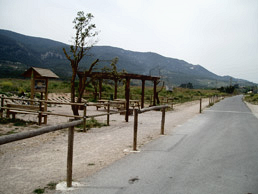
|
|
|
|
|
2. Accommodation |
|
|
|
|
|
|
3. Eco-tourism |
|
|
|
|
|
|
4. Managing Aurthority |
|
|
|
|
|
|
5. Town Councils |
|
|
|
|
|
|
6. Emergencies |
|
|
|
|
|
|
7. Coaches & Buses |
|
|
|
|
|
|
8. Railway |
|
|
|
|
|
|
|
Festivals and holidays
|
 return return |
|
|
|
|
|
|
|
Tibi
January 5 and 6
Les Dansaes. (Traditional dances to celebrate Epiphany)
July 20-25
Fiestas mayores with vaquillas (in which young fighting bulls are released into the square)
Easter Sunday
Enramaes (traditional festival in which the village is decorated with pine branches)
|
|
Agost
January 15-24
Fiestas de la Virgen de la Paz
June 29
Fiestas de Moros y Cristianos. (Moors and Christians Festival)
December 24-31
Fiestas del Rey Moro (typical folk dances) |
|
|
|
|
|
|
|
|
|
|
|
|
Accommodation
|
 return return |
|
|
|
|
|
|
|
Alcoi
Hotel Reconquista***
Tel. 96 533 09 00
www.hotelreconquista.es
Hostal Savoy*
Tel. 96 554 7272
www.hostalsavoy.com
Hostal Rural La Safranera (Parque Natural Font Roja)
Tel. 609 617 280
Casa Rural El Pinar
Tel. 610 298 089
|
|
Ibi
Hotel Plata*
Tel. 96 555 06 00
Hotel El Laurel
Tel. 96 555 29 45
www.hotalellaurel.com
Castalla
Hotel El Xorré de Cati
Tel. 96 556 04 00
|
|
|
|
|
|
|
|
|
|
|
|
|
Eco-tourism
|
 return return |
|
|
|
|
|
|
|
Club ciclista de Tibi. Telf. 96 561 70 45
Museo de la Alfarería de Agost. Telf. 96 569 11 99
Tourist Info Castalla. Tel. 96 656 0 18;
|
|
|
|
|
|
|
|
|
|
|
|
|
Managing Aurthority
|
 return return |
|
|
|
|
|
|
|
Diputación de Alicante
Área de Medio ambiente
Avda Orihuela, 128. 03006 Alicante
Tel: 965 107 400
mambient@dip-alicante.es
|
|
|
|
|
|
|
|
|
|
|
|
|
Town Councils
|
 return return |
|
|
|
|
|
|
|
Agost
Tel. 96 569 10 43
Tibi
Tel. 96 561 71 02
|
|
|
|
|
|
|
|
|
|
|
|
|
|
|
Emergencies
|
 return return |
|
|
|
|
|
|
|
EMERGENCIES: Tel. 062
|
|
|
|
|
|
|
|
|
|
|
|
|
Coaches & Buses
|
 return return |
|
|
|
|
|
|
|
Ibi, Castalla, Tibi
La Alcoyana. Línea Alcoi - Alicante. Tel. 96 552 05 62
Agost
Autobuses la Agostense. Línea Agost-Alicante Tel. 6 528 06 57
|
|
|
|
|
|
|
|
|
|
|
|
|
Railway
|
 return return |
|
|
|
|
|
|
|
Agost
Renfe. Tel. 96 353 71 72 / 45 / 31. www.renfe.es
Estación sin servicio regular de viajeros. Parada de trenes para grupos previa petición a Regionales de Renfe |
|
|
|
|
|
|
|
|
|
|
|
|
|
| Links
|
|
Página oficial de la Diputación de Alicante (Área de Medio Ambiente), órgano gestor de Vía Verde del Maigmó.
Portal oficial de turismo de la Comunitat Valenciana.
La Diputación de Alicante ofrece a través de esta web la información turística más completa de la provincia de Alicante: rutas, alojamientos, restaurantes y gastronomía, museos y fiestas...
Página oficial del Ayuntamiento de Alcoi a través de la cual encontrarás toda la información sobre la ciudad y la actualidad turÍstica.
Página oficial del Ayuntamiento de Agost con información sobre zonas turísticas, restaurantes, alojamientos, tiendas, rutas...
Web del Ayuntamiento de Tibi con toda la información del municipio desde su origen e historia pasando por su cultura, fiestas, deportes, tradiciones y gastronomía, sus lugares de interés, rutas, montañas, pantanos, ríos y barrancos, y sobre todo sus gentes.
Guía de senderos de pequeño recorrido de la provincia de Alicante. Diputación de Alicante. (versión en castellano)
Guía de senderos de pequeño recorrido de la provincia de Alicante. Diputación de Alicante. (versión en valenciano)
|
|
|
|
|
|
|
|
